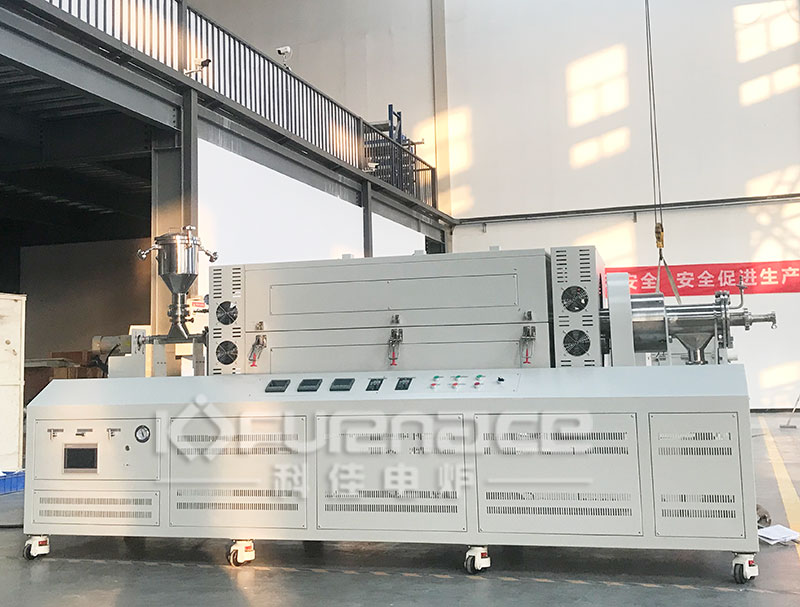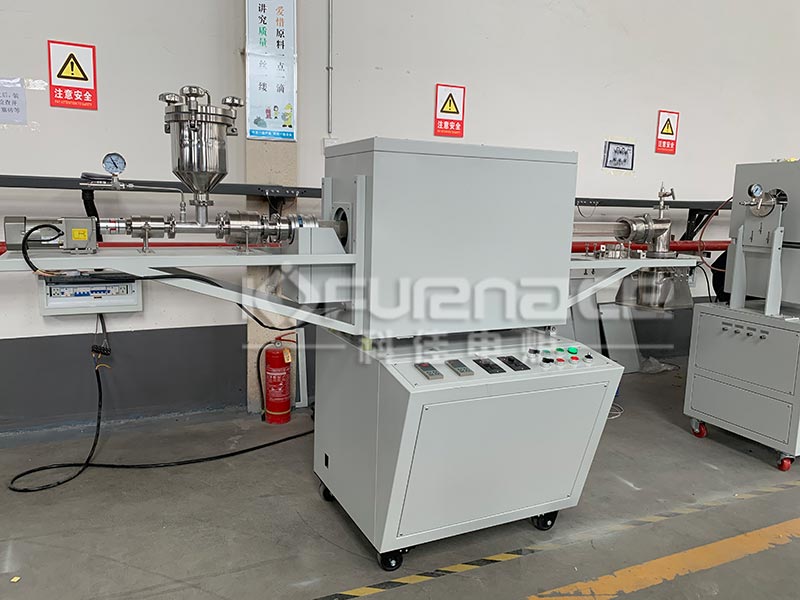When choosing an electric heating rotary tube furnace, the following key factors need to be considered to ensure that the selected equipment can meet your experimental or production needs:

Multi temperature zone rotary tube furnace that can be used to process powder materials (click on the image to view product details)
1. Maximum operating temperature
Determine the required temperature: First, specify the maximum temperature required for your experiment or production. The temperature requirements vary greatly among different experiments. For example, the pyrolysis experiment of organic compounds may require 300-600 ℃, while the melting of high-performance metal alloys may require high temperatures above 1800 ℃.
Choose the appropriate furnace type:
Below 1200 ℃: Molybdenum containing resistance wire heating elements are usually used.
1200-1400 ℃: Silicon carbon rod heating element can be selected.
Above 1400 ℃: Silicon molybdenum rod heating elements may be required.
Reserve temperature margin: In order to ensure the smooth progress of the experiment and cope with possible temperature demand changes in the future, it is recommended to reserve a temperature margin of 100-150 ℃. For example, if the actual required temperature is 1100 ℃, choosing a tube furnace with a maximum temperature of 1200 ℃ is more reliable.
2. Heating zone length and constant temperature zone length
Heating zone length: refers to the length covered by the heating element, which determines the size of the area that can be heated inside the furnace.
Constant temperature zone length: refers to the length within the heating zone where the temperature change in the central area is less than ± 1 ℃. It determines the size of the area where the sample can be uniformly heated. The length of the constant temperature zone is usually shorter than the total heating zone length.
Suggestion for selection: Ensure that the length of the constant temperature zone is greater than or equal to the length of your sample to ensure that the sample can be uniformly heated. If the sample is long, a tube furnace with a longer constant temperature zone needs to be selected.
3. Pipe diameter size
Select based on sample size: The diameter of the pipe should be determined according to the size and shape of the experimental sample. For larger reaction tubes or experiments that require processing large amounts of materials, it is necessary to choose a tube furnace with a larger diameter.
Considering reaction efficiency: In large-scale chemical reaction experiments, larger pipe diameters can ensure sufficient contact of reactants and efficient reaction. However, for experiments with trace samples, excessively large pipe diameters may not be conducive to heat concentration and stable temperature control.
4. Rotation and tilt function
Rotation function: The rotating tube furnace can evenly heat the sample during the heating process by rotating the furnace tube, improving the uniformity and efficiency of heat treatment. The rotation speed is usually adjustable to meet different experimental needs.
Tilt function: Some rotary tube furnaces have a tiltable design, which facilitates the collection, placement, and observation of samples. The tilt angle is also adjustable to accommodate different experimental setups and operating habits.
5. Control system and accuracy
Control system: Advanced control systems can achieve intelligent operation, including temperature setting, program control, automatic temperature rise and fall, etc. The microcomputer program control function allows users to input multiple temperature control curves to meet complex experimental requirements.
Temperature control accuracy: Temperature control accuracy directly affects the accuracy of experimental results. Choosing a tube furnace with high temperature control accuracy (such as ± 1 ℃) can ensure the stability and repeatability of the experimental process.
6. Furnace tube material and atmosphere protection
Furnace tube material: Select the appropriate furnace tube material based on the maximum working temperature. For example, quartz tubes are suitable for temperature ranges below 1200 ℃; Aluminum oxide tubes can be used for higher temperatures; Stainless steel and other metal pipes are cheap and suitable for larger pipe diameters.
Atmosphere protection: If the experiment needs to be conducted under vacuum or a specific atmosphere (such as inert gas), a tube furnace with vacuum and atmosphere protection functions should be selected. This can prevent the sample from reacting with the components in the air during the heating process, ensuring the accuracy of the experimental results.
7. Other considerations
Energy saving and environmental protection: Choosing a tube furnace with efficient and energy-saving design can reduce energy consumption and operating costs. At the same time, considering the environmental performance of the equipment, choose low emission and low pollution heating elements and furnace tube materials.
After sales service: Choose a supplier that provides good after-sales service, including equipment installation and commissioning, operation training, maintenance, etc. This can ensure that the equipment receives timely technical support and maintenance during use.

Commonly used tube rotary kilns (click on the image to view product details)
Overall, when choosing an electric heating rotary tube furnace, factors such as the maximum operating temperature, heating zone length and constant temperature zone length, pipe diameter size, rotation and tilt function, control system and accuracy, furnace tube material and atmosphere protection should be comprehensively considered. By carefully comparing the parameters and performance of different products, choose the tube furnace that is more suitable for your experimental or production needs. At the same time, pay attention to the energy-saving, environmental protection, and after-sales service of the equipment to ensure that it remains efficient, stable, and reliable during long-term use.Click to learn more tube furnaces! Or click on online customer service to learn more about product information!